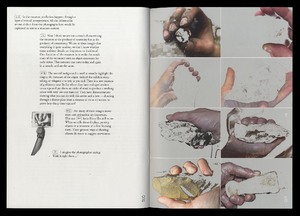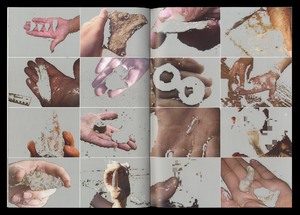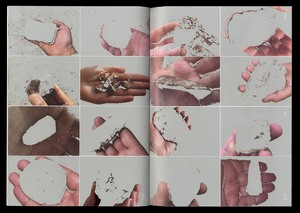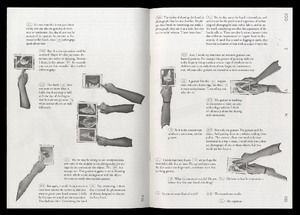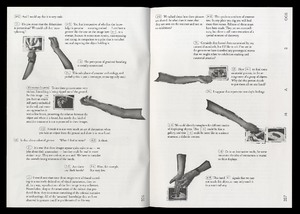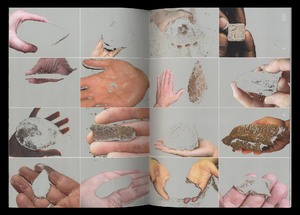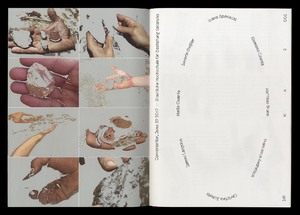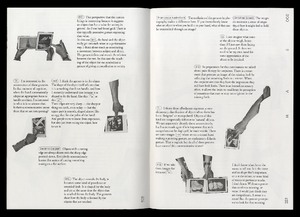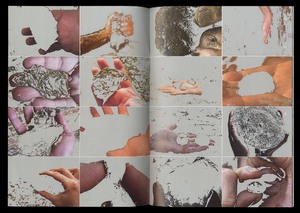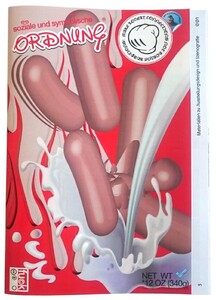Francesca Audretsch
| Name | Francesca Audretsch |
27 Inhalte
- Seite 1 von 3
MAS 005
- Titel
- MAS 005
- Untertitel
- Gestures and Displays
- Autor/in
- Beschreibung (de)
- Ausgangspunkt für diese Ausgabe ist eine Sammlung digitaler Bilder, die dem Designer James Langdon gehört. Diese Bilder - etwa 300 - gehören zu einer bestimmten Art von Bildern, die man häufig auf Websites und in Foren für Amateurarchäologie findet. Sie zeigen Gegenstände, die einst im Boden vergraben waren und nun ausgegraben und der Kamera präsentiert werden. Die Objekte selbst sind unterschiedlich und wahrscheinlich nicht wertvoll. Was diese Sammlung jedoch ausmacht, sind die Hände, die die Objekte halten: ihre Posen, Gesten und die Botschaften, die sie zu vermitteln scheinen.
Es sind Gesten der Darstellung. Die Positionen der Hände - flache, offene Handflächen; Griffe und Verschlüsse; anbietende und zeigende Zeichen - dienen als Rahmen, um die Objekte, die sie halten, zu vermitteln. Die Kamera erzwingt, dass es sich um kommunikative Gesten handelt, aber auch hier gibt es etwas Unmittelbares. Von Menschen gestaltete Objekte signalisieren anderen Menschen. Selbst die primitivsten Werkzeuge signalisieren unseren Händen: Nehmt mich, begehrt mich, seht mich an. In diesen Fotografien werden wir Zeuge des Empfangs dieser Signale - manchmal zweifelhaft, manchmal deterministisch, manchmal spekulativ - und wir sehen die zirkuläre Dynamik zwischen Hand, Auge und Gehirn auf dem Bildschirm.
Um das auf den folgenden Seiten wiedergegebene Gespräch zu ermöglichen, wurden Abzüge aus der Bildsammlung auf einem großen Arbeitstisch in der HfG Karlsruhe angeordnet. Um den Tisch herum breitete eine Gruppe von Kommentatoren die Bilder aus, verglich und diskutierte sie. Anwesend waren James Langdon, der Kunsthistoriker Matthias Bruhn, die Kuratorin Nadja Quante und das MAS-Redaktionsteam. Matthias Bruhn ist Professor für Kunstforschung und Medientheorie an der HfG Karlsruhe. Nadja Quante ist künstlerische Leiterin am Künstlerhaus Bremen. James Langdon ist Professor für Kommunikationsdesign an der HfG Karlsruhe.
- Ausgangspunkt für diese Ausgabe ist eine Sammlung digitaler Bilder, die dem Designer James Langdon gehört. Diese Bilder - etwa 300 - gehören zu einer bestimmten Art von Bildern, die man häufig auf Websites und in Foren für Amateurarchäologie findet. Sie zeigen Gegenstände, die einst im Boden vergraben waren und nun ausgegraben und der Kamera präsentiert werden. Die Objekte selbst sind unterschiedlich und wahrscheinlich nicht wertvoll. Was diese Sammlung jedoch ausmacht, sind die Hände, die die Objekte halten: ihre Posen, Gesten und die Botschaften, die sie zu vermitteln scheinen.
- Beschreibung (en)
- The starting point for this issue is a collection of digital images belonging to designer James Langdon. These images — around 300 — are of a specific type, readily found on amateur archaeology websites and forums. They show objects once buried in the ground, now dug up and presented to the camera. The objects themselves are various and probably not valuable. What defines this collection, though, are the hands that hold the objects: their poses, gestures, and the messages they seem to convey.
These are gestures of display. The positions of the hands — flat, open palms; grips and closures; offering and pointing signs — serve as a frame to mediate the objects they hold. The camera forces these to be communicative gestures, but there is something immediate here too. Objects shaped by humans signal to other humans. Even the most primitive tools make affordances that signal to our hands: wield me, covet me, behold me. In these photographs we witness the reception of these signals — sometimes doubtful, sometimes deterministic, sometimes speculative — and we see the circular dynamic between hand, eye, and brain on display.
To facilitate the conversation reproduced on the following pages, prints from the image collection were arranged on a large working table in the HfG Karlsruhe. Around the table a group of commentators spread the images out, compared and discussed them. Present were James Langdon, art historian Matthias Bruhn, curator Nadja Quante, and the MAS editorial team. Matthias Bruhn is professor for art research and media theory at HfG Karlsruhe. Nadja Quante is artistic director at Künstlerhaus Bremen. James Langdon is professor for communication design at HfG Karlsruhe.
- The starting point for this issue is a collection of digital images belonging to designer James Langdon. These images — around 300 — are of a specific type, readily found on amateur archaeology websites and forums. They show objects once buried in the ground, now dug up and presented to the camera. The objects themselves are various and probably not valuable. What defines this collection, though, are the hands that hold the objects: their poses, gestures, and the messages they seem to convey.
- Typ des Projekts/Werks
- Schlagworte
- Mitwirkende
- Sprache
- Abmessungen
- DinA 4
- Ort: Institution
- Stadt
- Land
- Bemerkungen
- Heft 5: Gestures and Displays
2018-2020
Cover: Heike Schuppelius
Grafik Credits: Cécile Kobel und Severin Geißler
- Heft 5: Gestures and Displays
- Titel
- MAS 005
- Urheberrechtshinweis
- Ausstellungsdesign und Szenografie
- Rechtsschutz/Lizenz
- Beziehung/Funktion
- Projektleiter/in
- Lehrveranstaltung
- Importiert am
- 15.12.2023
- Übergeordnete Sets
- 1
MAS 005
- Titel
- MAS 005
- Untertitel
- Gestures and Displays
- Autor/in
- Beschreibung (de)
- Ausgangspunkt für diese Ausgabe ist eine Sammlung digitaler Bilder, die dem Designer James Langdon gehört. Diese Bilder - etwa 300 - gehören zu einer bestimmten Art von Bildern, die man häufig auf Websites und in Foren für Amateurarchäologie findet. Sie zeigen Gegenstände, die einst im Boden vergraben waren und nun ausgegraben und der Kamera präsentiert werden. Die Objekte selbst sind unterschiedlich und wahrscheinlich nicht wertvoll. Was diese Sammlung jedoch ausmacht, sind die Hände, die die Objekte halten: ihre Posen, Gesten und die Botschaften, die sie zu vermitteln scheinen.
Es sind Gesten der Darstellung. Die Positionen der Hände - flache, offene Handflächen; Griffe und Verschlüsse; anbietende und zeigende Zeichen - dienen als Rahmen, um die Objekte, die sie halten, zu vermitteln. Die Kamera erzwingt, dass es sich um kommunikative Gesten handelt, aber auch hier gibt es etwas Unmittelbares. Von Menschen gestaltete Objekte signalisieren anderen Menschen. Selbst die primitivsten Werkzeuge signalisieren unseren Händen: Nehmt mich, begehrt mich, seht mich an. In diesen Fotografien werden wir Zeuge des Empfangs dieser Signale - manchmal zweifelhaft, manchmal deterministisch, manchmal spekulativ - und wir sehen die zirkuläre Dynamik zwischen Hand, Auge und Gehirn auf dem Bildschirm.
Um das auf den folgenden Seiten wiedergegebene Gespräch zu ermöglichen, wurden Abzüge aus der Bildsammlung auf einem großen Arbeitstisch in der HfG Karlsruhe angeordnet. Um den Tisch herum breitete eine Gruppe von Kommentatoren die Bilder aus, verglich und diskutierte sie. Anwesend waren James Langdon, der Kunsthistoriker Matthias Bruhn, die Kuratorin Nadja Quante und das MAS-Redaktionsteam. Matthias Bruhn ist Professor für Kunstforschung und Medientheorie an der HfG Karlsruhe. Nadja Quante ist künstlerische Leiterin am Künstlerhaus Bremen. James Langdon ist Professor für Kommunikationsdesign an der HfG Karlsruhe.
- Ausgangspunkt für diese Ausgabe ist eine Sammlung digitaler Bilder, die dem Designer James Langdon gehört. Diese Bilder - etwa 300 - gehören zu einer bestimmten Art von Bildern, die man häufig auf Websites und in Foren für Amateurarchäologie findet. Sie zeigen Gegenstände, die einst im Boden vergraben waren und nun ausgegraben und der Kamera präsentiert werden. Die Objekte selbst sind unterschiedlich und wahrscheinlich nicht wertvoll. Was diese Sammlung jedoch ausmacht, sind die Hände, die die Objekte halten: ihre Posen, Gesten und die Botschaften, die sie zu vermitteln scheinen.
- Beschreibung (en)
- The starting point for this issue is a collection of digital images belonging to designer James Langdon. These images — around 300 — are of a specific type, readily found on amateur archaeology websites and forums. They show objects once buried in the ground, now dug up and presented to the camera. The objects themselves are various and probably not valuable. What defines this collection, though, are the hands that hold the objects: their poses, gestures, and the messages they seem to convey.
These are gestures of display. The positions of the hands — flat, open palms; grips and closures; offering and pointing signs — serve as a frame to mediate the objects they hold. The camera forces these to be communicative gestures, but there is something immediate here too. Objects shaped by humans signal to other humans. Even the most primitive tools make affordances that signal to our hands: wield me, covet me, behold me. In these photographs we witness the reception of these signals — sometimes doubtful, sometimes deterministic, sometimes speculative — and we see the circular dynamic between hand, eye, and brain on display.
To facilitate the conversation reproduced on the following pages, prints from the image collection were arranged on a large working table in the HfG Karlsruhe. Around the table a group of commentators spread the images out, compared and discussed them. Present were James Langdon, art historian Matthias Bruhn, curator Nadja Quante, and the MAS editorial team. Matthias Bruhn is professor for art research and media theory at HfG Karlsruhe. Nadja Quante is artistic director at Künstlerhaus Bremen. James Langdon is professor for communication design at HfG Karlsruhe.
- The starting point for this issue is a collection of digital images belonging to designer James Langdon. These images — around 300 — are of a specific type, readily found on amateur archaeology websites and forums. They show objects once buried in the ground, now dug up and presented to the camera. The objects themselves are various and probably not valuable. What defines this collection, though, are the hands that hold the objects: their poses, gestures, and the messages they seem to convey.
- Typ des Projekts/Werks
- Schlagworte
- Mitwirkende
- Sprache
- Abmessungen
- DinA 4
- Ort: Institution
- Stadt
- Land
- Bemerkungen
- Heft 5: Gestures and Displays
2018-2020
Cover: Heike Schuppelius
Grafik Credits: Cécile Kobel und Severin Geißler
- Heft 5: Gestures and Displays
- Titel
- MAS 005
- Urheberrechtshinweis
- Ausstellungsdesign und Szenografie
- Rechtsschutz/Lizenz
- Beziehung/Funktion
- Projektleiter/in
- Lehrveranstaltung
- Importiert am
- 15.12.2023
- Übergeordnete Sets
- 1
MAS 005
- Titel
- MAS 005
- Untertitel
- Gestures and Displays
- Autor/in
- Beschreibung (de)
- Ausgangspunkt für diese Ausgabe ist eine Sammlung digitaler Bilder, die dem Designer James Langdon gehört. Diese Bilder - etwa 300 - gehören zu einer bestimmten Art von Bildern, die man häufig auf Websites und in Foren für Amateurarchäologie findet. Sie zeigen Gegenstände, die einst im Boden vergraben waren und nun ausgegraben und der Kamera präsentiert werden. Die Objekte selbst sind unterschiedlich und wahrscheinlich nicht wertvoll. Was diese Sammlung jedoch ausmacht, sind die Hände, die die Objekte halten: ihre Posen, Gesten und die Botschaften, die sie zu vermitteln scheinen.
Es sind Gesten der Darstellung. Die Positionen der Hände - flache, offene Handflächen; Griffe und Verschlüsse; anbietende und zeigende Zeichen - dienen als Rahmen, um die Objekte, die sie halten, zu vermitteln. Die Kamera erzwingt, dass es sich um kommunikative Gesten handelt, aber auch hier gibt es etwas Unmittelbares. Von Menschen gestaltete Objekte signalisieren anderen Menschen. Selbst die primitivsten Werkzeuge signalisieren unseren Händen: Nehmt mich, begehrt mich, seht mich an. In diesen Fotografien werden wir Zeuge des Empfangs dieser Signale - manchmal zweifelhaft, manchmal deterministisch, manchmal spekulativ - und wir sehen die zirkuläre Dynamik zwischen Hand, Auge und Gehirn auf dem Bildschirm.
Um das auf den folgenden Seiten wiedergegebene Gespräch zu ermöglichen, wurden Abzüge aus der Bildsammlung auf einem großen Arbeitstisch in der HfG Karlsruhe angeordnet. Um den Tisch herum breitete eine Gruppe von Kommentatoren die Bilder aus, verglich und diskutierte sie. Anwesend waren James Langdon, der Kunsthistoriker Matthias Bruhn, die Kuratorin Nadja Quante und das MAS-Redaktionsteam. Matthias Bruhn ist Professor für Kunstforschung und Medientheorie an der HfG Karlsruhe. Nadja Quante ist künstlerische Leiterin am Künstlerhaus Bremen. James Langdon ist Professor für Kommunikationsdesign an der HfG Karlsruhe.
- Ausgangspunkt für diese Ausgabe ist eine Sammlung digitaler Bilder, die dem Designer James Langdon gehört. Diese Bilder - etwa 300 - gehören zu einer bestimmten Art von Bildern, die man häufig auf Websites und in Foren für Amateurarchäologie findet. Sie zeigen Gegenstände, die einst im Boden vergraben waren und nun ausgegraben und der Kamera präsentiert werden. Die Objekte selbst sind unterschiedlich und wahrscheinlich nicht wertvoll. Was diese Sammlung jedoch ausmacht, sind die Hände, die die Objekte halten: ihre Posen, Gesten und die Botschaften, die sie zu vermitteln scheinen.
- Beschreibung (en)
- The starting point for this issue is a collection of digital images belonging to designer James Langdon. These images — around 300 — are of a specific type, readily found on amateur archaeology websites and forums. They show objects once buried in the ground, now dug up and presented to the camera. The objects themselves are various and probably not valuable. What defines this collection, though, are the hands that hold the objects: their poses, gestures, and the messages they seem to convey.
These are gestures of display. The positions of the hands — flat, open palms; grips and closures; offering and pointing signs — serve as a frame to mediate the objects they hold. The camera forces these to be communicative gestures, but there is something immediate here too. Objects shaped by humans signal to other humans. Even the most primitive tools make affordances that signal to our hands: wield me, covet me, behold me. In these photographs we witness the reception of these signals — sometimes doubtful, sometimes deterministic, sometimes speculative — and we see the circular dynamic between hand, eye, and brain on display.
To facilitate the conversation reproduced on the following pages, prints from the image collection were arranged on a large working table in the HfG Karlsruhe. Around the table a group of commentators spread the images out, compared and discussed them. Present were James Langdon, art historian Matthias Bruhn, curator Nadja Quante, and the MAS editorial team. Matthias Bruhn is professor for art research and media theory at HfG Karlsruhe. Nadja Quante is artistic director at Künstlerhaus Bremen. James Langdon is professor for communication design at HfG Karlsruhe.
- The starting point for this issue is a collection of digital images belonging to designer James Langdon. These images — around 300 — are of a specific type, readily found on amateur archaeology websites and forums. They show objects once buried in the ground, now dug up and presented to the camera. The objects themselves are various and probably not valuable. What defines this collection, though, are the hands that hold the objects: their poses, gestures, and the messages they seem to convey.
- Typ des Projekts/Werks
- Schlagworte
- Mitwirkende
- Sprache
- Abmessungen
- DinA 4
- Ort: Institution
- Stadt
- Land
- Bemerkungen
- Heft 5: Gestures and Displays
2018-2020
Cover: Heike Schuppelius
Grafik Credits: Cécile Kobel und Severin Geißler
- Heft 5: Gestures and Displays
- Titel
- MAS 005
- Urheberrechtshinweis
- Ausstellungsdesign und Szenografie
- Rechtsschutz/Lizenz
- Beziehung/Funktion
- Projektleiter/in
- Lehrveranstaltung
- Importiert am
- 15.12.2023
- Übergeordnete Sets
- 1
MAS 005
- Titel
- MAS 005
- Untertitel
- Gestures and Displays
- Autor/in
- Beschreibung (de)
- Ausgangspunkt für diese Ausgabe ist eine Sammlung digitaler Bilder, die dem Designer James Langdon gehört. Diese Bilder - etwa 300 - gehören zu einer bestimmten Art von Bildern, die man häufig auf Websites und in Foren für Amateurarchäologie findet. Sie zeigen Gegenstände, die einst im Boden vergraben waren und nun ausgegraben und der Kamera präsentiert werden. Die Objekte selbst sind unterschiedlich und wahrscheinlich nicht wertvoll. Was diese Sammlung jedoch ausmacht, sind die Hände, die die Objekte halten: ihre Posen, Gesten und die Botschaften, die sie zu vermitteln scheinen.
Es sind Gesten der Darstellung. Die Positionen der Hände - flache, offene Handflächen; Griffe und Verschlüsse; anbietende und zeigende Zeichen - dienen als Rahmen, um die Objekte, die sie halten, zu vermitteln. Die Kamera erzwingt, dass es sich um kommunikative Gesten handelt, aber auch hier gibt es etwas Unmittelbares. Von Menschen gestaltete Objekte signalisieren anderen Menschen. Selbst die primitivsten Werkzeuge signalisieren unseren Händen: Nehmt mich, begehrt mich, seht mich an. In diesen Fotografien werden wir Zeuge des Empfangs dieser Signale - manchmal zweifelhaft, manchmal deterministisch, manchmal spekulativ - und wir sehen die zirkuläre Dynamik zwischen Hand, Auge und Gehirn auf dem Bildschirm.
Um das auf den folgenden Seiten wiedergegebene Gespräch zu ermöglichen, wurden Abzüge aus der Bildsammlung auf einem großen Arbeitstisch in der HfG Karlsruhe angeordnet. Um den Tisch herum breitete eine Gruppe von Kommentatoren die Bilder aus, verglich und diskutierte sie. Anwesend waren James Langdon, der Kunsthistoriker Matthias Bruhn, die Kuratorin Nadja Quante und das MAS-Redaktionsteam. Matthias Bruhn ist Professor für Kunstforschung und Medientheorie an der HfG Karlsruhe. Nadja Quante ist künstlerische Leiterin am Künstlerhaus Bremen. James Langdon ist Professor für Kommunikationsdesign an der HfG Karlsruhe.
- Ausgangspunkt für diese Ausgabe ist eine Sammlung digitaler Bilder, die dem Designer James Langdon gehört. Diese Bilder - etwa 300 - gehören zu einer bestimmten Art von Bildern, die man häufig auf Websites und in Foren für Amateurarchäologie findet. Sie zeigen Gegenstände, die einst im Boden vergraben waren und nun ausgegraben und der Kamera präsentiert werden. Die Objekte selbst sind unterschiedlich und wahrscheinlich nicht wertvoll. Was diese Sammlung jedoch ausmacht, sind die Hände, die die Objekte halten: ihre Posen, Gesten und die Botschaften, die sie zu vermitteln scheinen.
- Beschreibung (en)
- The starting point for this issue is a collection of digital images belonging to designer James Langdon. These images — around 300 — are of a specific type, readily found on amateur archaeology websites and forums. They show objects once buried in the ground, now dug up and presented to the camera. The objects themselves are various and probably not valuable. What defines this collection, though, are the hands that hold the objects: their poses, gestures, and the messages they seem to convey.
These are gestures of display. The positions of the hands — flat, open palms; grips and closures; offering and pointing signs — serve as a frame to mediate the objects they hold. The camera forces these to be communicative gestures, but there is something immediate here too. Objects shaped by humans signal to other humans. Even the most primitive tools make affordances that signal to our hands: wield me, covet me, behold me. In these photographs we witness the reception of these signals — sometimes doubtful, sometimes deterministic, sometimes speculative — and we see the circular dynamic between hand, eye, and brain on display.
To facilitate the conversation reproduced on the following pages, prints from the image collection were arranged on a large working table in the HfG Karlsruhe. Around the table a group of commentators spread the images out, compared and discussed them. Present were James Langdon, art historian Matthias Bruhn, curator Nadja Quante, and the MAS editorial team. Matthias Bruhn is professor for art research and media theory at HfG Karlsruhe. Nadja Quante is artistic director at Künstlerhaus Bremen. James Langdon is professor for communication design at HfG Karlsruhe.
- The starting point for this issue is a collection of digital images belonging to designer James Langdon. These images — around 300 — are of a specific type, readily found on amateur archaeology websites and forums. They show objects once buried in the ground, now dug up and presented to the camera. The objects themselves are various and probably not valuable. What defines this collection, though, are the hands that hold the objects: their poses, gestures, and the messages they seem to convey.
- Typ des Projekts/Werks
- Schlagworte
- Mitwirkende
- Sprache
- Abmessungen
- DinA 4
- Ort: Institution
- Stadt
- Land
- Bemerkungen
- Heft 5: Gestures and Displays
2018-2020
Cover: Heike Schuppelius
Grafik Credits: Cécile Kobel und Severin Geißler
- Heft 5: Gestures and Displays
- Titel
- MAS 005
- Urheberrechtshinweis
- Ausstellungsdesign und Szenografie
- Rechtsschutz/Lizenz
- Beziehung/Funktion
- Projektleiter/in
- Lehrveranstaltung
- Importiert am
- 15.12.2023
- Übergeordnete Sets
- 1
MAS 005
- Titel
- MAS 005
- Untertitel
- Gestures and Displays
- Autor/in
- Beschreibung (de)
- Ausgangspunkt für diese Ausgabe ist eine Sammlung digitaler Bilder, die dem Designer James Langdon gehört. Diese Bilder - etwa 300 - gehören zu einer bestimmten Art von Bildern, die man häufig auf Websites und in Foren für Amateurarchäologie findet. Sie zeigen Gegenstände, die einst im Boden vergraben waren und nun ausgegraben und der Kamera präsentiert werden. Die Objekte selbst sind unterschiedlich und wahrscheinlich nicht wertvoll. Was diese Sammlung jedoch ausmacht, sind die Hände, die die Objekte halten: ihre Posen, Gesten und die Botschaften, die sie zu vermitteln scheinen.
Es sind Gesten der Darstellung. Die Positionen der Hände - flache, offene Handflächen; Griffe und Verschlüsse; anbietende und zeigende Zeichen - dienen als Rahmen, um die Objekte, die sie halten, zu vermitteln. Die Kamera erzwingt, dass es sich um kommunikative Gesten handelt, aber auch hier gibt es etwas Unmittelbares. Von Menschen gestaltete Objekte signalisieren anderen Menschen. Selbst die primitivsten Werkzeuge signalisieren unseren Händen: Nehmt mich, begehrt mich, seht mich an. In diesen Fotografien werden wir Zeuge des Empfangs dieser Signale - manchmal zweifelhaft, manchmal deterministisch, manchmal spekulativ - und wir sehen die zirkuläre Dynamik zwischen Hand, Auge und Gehirn auf dem Bildschirm.
Um das auf den folgenden Seiten wiedergegebene Gespräch zu ermöglichen, wurden Abzüge aus der Bildsammlung auf einem großen Arbeitstisch in der HfG Karlsruhe angeordnet. Um den Tisch herum breitete eine Gruppe von Kommentatoren die Bilder aus, verglich und diskutierte sie. Anwesend waren James Langdon, der Kunsthistoriker Matthias Bruhn, die Kuratorin Nadja Quante und das MAS-Redaktionsteam. Matthias Bruhn ist Professor für Kunstforschung und Medientheorie an der HfG Karlsruhe. Nadja Quante ist künstlerische Leiterin am Künstlerhaus Bremen. James Langdon ist Professor für Kommunikationsdesign an der HfG Karlsruhe.
- Ausgangspunkt für diese Ausgabe ist eine Sammlung digitaler Bilder, die dem Designer James Langdon gehört. Diese Bilder - etwa 300 - gehören zu einer bestimmten Art von Bildern, die man häufig auf Websites und in Foren für Amateurarchäologie findet. Sie zeigen Gegenstände, die einst im Boden vergraben waren und nun ausgegraben und der Kamera präsentiert werden. Die Objekte selbst sind unterschiedlich und wahrscheinlich nicht wertvoll. Was diese Sammlung jedoch ausmacht, sind die Hände, die die Objekte halten: ihre Posen, Gesten und die Botschaften, die sie zu vermitteln scheinen.
- Beschreibung (en)
- The starting point for this issue is a collection of digital images belonging to designer James Langdon. These images — around 300 — are of a specific type, readily found on amateur archaeology websites and forums. They show objects once buried in the ground, now dug up and presented to the camera. The objects themselves are various and probably not valuable. What defines this collection, though, are the hands that hold the objects: their poses, gestures, and the messages they seem to convey.
These are gestures of display. The positions of the hands — flat, open palms; grips and closures; offering and pointing signs — serve as a frame to mediate the objects they hold. The camera forces these to be communicative gestures, but there is something immediate here too. Objects shaped by humans signal to other humans. Even the most primitive tools make affordances that signal to our hands: wield me, covet me, behold me. In these photographs we witness the reception of these signals — sometimes doubtful, sometimes deterministic, sometimes speculative — and we see the circular dynamic between hand, eye, and brain on display.
To facilitate the conversation reproduced on the following pages, prints from the image collection were arranged on a large working table in the HfG Karlsruhe. Around the table a group of commentators spread the images out, compared and discussed them. Present were James Langdon, art historian Matthias Bruhn, curator Nadja Quante, and the MAS editorial team. Matthias Bruhn is professor for art research and media theory at HfG Karlsruhe. Nadja Quante is artistic director at Künstlerhaus Bremen. James Langdon is professor for communication design at HfG Karlsruhe.
- The starting point for this issue is a collection of digital images belonging to designer James Langdon. These images — around 300 — are of a specific type, readily found on amateur archaeology websites and forums. They show objects once buried in the ground, now dug up and presented to the camera. The objects themselves are various and probably not valuable. What defines this collection, though, are the hands that hold the objects: their poses, gestures, and the messages they seem to convey.
- Typ des Projekts/Werks
- Schlagworte
- Mitwirkende
- Sprache
- Abmessungen
- DinA 4
- Ort: Institution
- Stadt
- Land
- Bemerkungen
- Heft 5: Gestures and Displays
2018-2020
Cover: Heike Schuppelius
Grafik Credits: Cécile Kobel und Severin Geißler
- Heft 5: Gestures and Displays
- Titel
- MAS 005
- Urheberrechtshinweis
- Ausstellungsdesign und Szenografie
- Rechtsschutz/Lizenz
- Beziehung/Funktion
- Projektleiter/in
- Lehrveranstaltung
- Importiert am
- 15.12.2023
- Übergeordnete Sets
- 1
MAS 005
- Titel
- MAS 005
- Untertitel
- Gestures and Displays
- Autor/in
- Beschreibung (de)
- Ausgangspunkt für diese Ausgabe ist eine Sammlung digitaler Bilder, die dem Designer James Langdon gehört. Diese Bilder - etwa 300 - gehören zu einer bestimmten Art von Bildern, die man häufig auf Websites und in Foren für Amateurarchäologie findet. Sie zeigen Gegenstände, die einst im Boden vergraben waren und nun ausgegraben und der Kamera präsentiert werden. Die Objekte selbst sind unterschiedlich und wahrscheinlich nicht wertvoll. Was diese Sammlung jedoch ausmacht, sind die Hände, die die Objekte halten: ihre Posen, Gesten und die Botschaften, die sie zu vermitteln scheinen.
Es sind Gesten der Darstellung. Die Positionen der Hände - flache, offene Handflächen; Griffe und Verschlüsse; anbietende und zeigende Zeichen - dienen als Rahmen, um die Objekte, die sie halten, zu vermitteln. Die Kamera erzwingt, dass es sich um kommunikative Gesten handelt, aber auch hier gibt es etwas Unmittelbares. Von Menschen gestaltete Objekte signalisieren anderen Menschen. Selbst die primitivsten Werkzeuge signalisieren unseren Händen: Nehmt mich, begehrt mich, seht mich an. In diesen Fotografien werden wir Zeuge des Empfangs dieser Signale - manchmal zweifelhaft, manchmal deterministisch, manchmal spekulativ - und wir sehen die zirkuläre Dynamik zwischen Hand, Auge und Gehirn auf dem Bildschirm.
Um das auf den folgenden Seiten wiedergegebene Gespräch zu ermöglichen, wurden Abzüge aus der Bildsammlung auf einem großen Arbeitstisch in der HfG Karlsruhe angeordnet. Um den Tisch herum breitete eine Gruppe von Kommentatoren die Bilder aus, verglich und diskutierte sie. Anwesend waren James Langdon, der Kunsthistoriker Matthias Bruhn, die Kuratorin Nadja Quante und das MAS-Redaktionsteam. Matthias Bruhn ist Professor für Kunstforschung und Medientheorie an der HfG Karlsruhe. Nadja Quante ist künstlerische Leiterin am Künstlerhaus Bremen. James Langdon ist Professor für Kommunikationsdesign an der HfG Karlsruhe.
- Ausgangspunkt für diese Ausgabe ist eine Sammlung digitaler Bilder, die dem Designer James Langdon gehört. Diese Bilder - etwa 300 - gehören zu einer bestimmten Art von Bildern, die man häufig auf Websites und in Foren für Amateurarchäologie findet. Sie zeigen Gegenstände, die einst im Boden vergraben waren und nun ausgegraben und der Kamera präsentiert werden. Die Objekte selbst sind unterschiedlich und wahrscheinlich nicht wertvoll. Was diese Sammlung jedoch ausmacht, sind die Hände, die die Objekte halten: ihre Posen, Gesten und die Botschaften, die sie zu vermitteln scheinen.
- Beschreibung (en)
- The starting point for this issue is a collection of digital images belonging to designer James Langdon. These images — around 300 — are of a specific type, readily found on amateur archaeology websites and forums. They show objects once buried in the ground, now dug up and presented to the camera. The objects themselves are various and probably not valuable. What defines this collection, though, are the hands that hold the objects: their poses, gestures, and the messages they seem to convey.
These are gestures of display. The positions of the hands — flat, open palms; grips and closures; offering and pointing signs — serve as a frame to mediate the objects they hold. The camera forces these to be communicative gestures, but there is something immediate here too. Objects shaped by humans signal to other humans. Even the most primitive tools make affordances that signal to our hands: wield me, covet me, behold me. In these photographs we witness the reception of these signals — sometimes doubtful, sometimes deterministic, sometimes speculative — and we see the circular dynamic between hand, eye, and brain on display.
To facilitate the conversation reproduced on the following pages, prints from the image collection were arranged on a large working table in the HfG Karlsruhe. Around the table a group of commentators spread the images out, compared and discussed them. Present were James Langdon, art historian Matthias Bruhn, curator Nadja Quante, and the MAS editorial team. Matthias Bruhn is professor for art research and media theory at HfG Karlsruhe. Nadja Quante is artistic director at Künstlerhaus Bremen. James Langdon is professor for communication design at HfG Karlsruhe.
- The starting point for this issue is a collection of digital images belonging to designer James Langdon. These images — around 300 — are of a specific type, readily found on amateur archaeology websites and forums. They show objects once buried in the ground, now dug up and presented to the camera. The objects themselves are various and probably not valuable. What defines this collection, though, are the hands that hold the objects: their poses, gestures, and the messages they seem to convey.
- Typ des Projekts/Werks
- Schlagworte
- Mitwirkende
- Sprache
- Abmessungen
- DinA 4
- Ort: Institution
- Stadt
- Land
- Bemerkungen
- Heft 5: Gestures and Displays
2018-2020
Cover: Heike Schuppelius
Grafik Credits: Cécile Kobel und Severin Geißler
- Heft 5: Gestures and Displays
- Titel
- MAS 005
- Urheberrechtshinweis
- Ausstellungsdesign und Szenografie
- Rechtsschutz/Lizenz
- Beziehung/Funktion
- Projektleiter/in
- Lehrveranstaltung
- Importiert am
- 15.12.2023
- Übergeordnete Sets
- 1
MAS 005
- Titel
- MAS 005
- Untertitel
- Gestures and Displays
- Autor/in
- Beschreibung (de)
- Ausgangspunkt für diese Ausgabe ist eine Sammlung digitaler Bilder, die dem Designer James Langdon gehört. Diese Bilder - etwa 300 - gehören zu einer bestimmten Art von Bildern, die man häufig auf Websites und in Foren für Amateurarchäologie findet. Sie zeigen Gegenstände, die einst im Boden vergraben waren und nun ausgegraben und der Kamera präsentiert werden. Die Objekte selbst sind unterschiedlich und wahrscheinlich nicht wertvoll. Was diese Sammlung jedoch ausmacht, sind die Hände, die die Objekte halten: ihre Posen, Gesten und die Botschaften, die sie zu vermitteln scheinen.
Es sind Gesten der Darstellung. Die Positionen der Hände - flache, offene Handflächen; Griffe und Verschlüsse; anbietende und zeigende Zeichen - dienen als Rahmen, um die Objekte, die sie halten, zu vermitteln. Die Kamera erzwingt, dass es sich um kommunikative Gesten handelt, aber auch hier gibt es etwas Unmittelbares. Von Menschen gestaltete Objekte signalisieren anderen Menschen. Selbst die primitivsten Werkzeuge signalisieren unseren Händen: Nehmt mich, begehrt mich, seht mich an. In diesen Fotografien werden wir Zeuge des Empfangs dieser Signale - manchmal zweifelhaft, manchmal deterministisch, manchmal spekulativ - und wir sehen die zirkuläre Dynamik zwischen Hand, Auge und Gehirn auf dem Bildschirm.
Um das auf den folgenden Seiten wiedergegebene Gespräch zu ermöglichen, wurden Abzüge aus der Bildsammlung auf einem großen Arbeitstisch in der HfG Karlsruhe angeordnet. Um den Tisch herum breitete eine Gruppe von Kommentatoren die Bilder aus, verglich und diskutierte sie. Anwesend waren James Langdon, der Kunsthistoriker Matthias Bruhn, die Kuratorin Nadja Quante und das MAS-Redaktionsteam. Matthias Bruhn ist Professor für Kunstforschung und Medientheorie an der HfG Karlsruhe. Nadja Quante ist künstlerische Leiterin am Künstlerhaus Bremen. James Langdon ist Professor für Kommunikationsdesign an der HfG Karlsruhe.
- Ausgangspunkt für diese Ausgabe ist eine Sammlung digitaler Bilder, die dem Designer James Langdon gehört. Diese Bilder - etwa 300 - gehören zu einer bestimmten Art von Bildern, die man häufig auf Websites und in Foren für Amateurarchäologie findet. Sie zeigen Gegenstände, die einst im Boden vergraben waren und nun ausgegraben und der Kamera präsentiert werden. Die Objekte selbst sind unterschiedlich und wahrscheinlich nicht wertvoll. Was diese Sammlung jedoch ausmacht, sind die Hände, die die Objekte halten: ihre Posen, Gesten und die Botschaften, die sie zu vermitteln scheinen.
- Beschreibung (en)
- The starting point for this issue is a collection of digital images belonging to designer James Langdon. These images — around 300 — are of a specific type, readily found on amateur archaeology websites and forums. They show objects once buried in the ground, now dug up and presented to the camera. The objects themselves are various and probably not valuable. What defines this collection, though, are the hands that hold the objects: their poses, gestures, and the messages they seem to convey.
These are gestures of display. The positions of the hands — flat, open palms; grips and closures; offering and pointing signs — serve as a frame to mediate the objects they hold. The camera forces these to be communicative gestures, but there is something immediate here too. Objects shaped by humans signal to other humans. Even the most primitive tools make affordances that signal to our hands: wield me, covet me, behold me. In these photographs we witness the reception of these signals — sometimes doubtful, sometimes deterministic, sometimes speculative — and we see the circular dynamic between hand, eye, and brain on display.
To facilitate the conversation reproduced on the following pages, prints from the image collection were arranged on a large working table in the HfG Karlsruhe. Around the table a group of commentators spread the images out, compared and discussed them. Present were James Langdon, art historian Matthias Bruhn, curator Nadja Quante, and the MAS editorial team. Matthias Bruhn is professor for art research and media theory at HfG Karlsruhe. Nadja Quante is artistic director at Künstlerhaus Bremen. James Langdon is professor for communication design at HfG Karlsruhe.
- The starting point for this issue is a collection of digital images belonging to designer James Langdon. These images — around 300 — are of a specific type, readily found on amateur archaeology websites and forums. They show objects once buried in the ground, now dug up and presented to the camera. The objects themselves are various and probably not valuable. What defines this collection, though, are the hands that hold the objects: their poses, gestures, and the messages they seem to convey.
- Typ des Projekts/Werks
- Schlagworte
- Mitwirkende
- Sprache
- Abmessungen
- DinA 4
- Ort: Institution
- Stadt
- Land
- Bemerkungen
- Heft 5: Gestures and Displays
2018-2020
Cover: Heike Schuppelius
Grafik Credits: Cécile Kobel und Severin Geißler
- Heft 5: Gestures and Displays
- Titel
- MAS 005
- Urheberrechtshinweis
- Ausstellungsdesign und Szenografie
- Rechtsschutz/Lizenz
- Beziehung/Funktion
- Projektleiter/in
- Lehrveranstaltung
- Importiert am
- 15.12.2023
- Übergeordnete Sets
- 1
MAS 005
- Titel
- MAS 005
- Untertitel
- Gestures and Displays
- Autor/in
- Beschreibung (de)
- Ausgangspunkt für diese Ausgabe ist eine Sammlung digitaler Bilder, die dem Designer James Langdon gehört. Diese Bilder - etwa 300 - gehören zu einer bestimmten Art von Bildern, die man häufig auf Websites und in Foren für Amateurarchäologie findet. Sie zeigen Gegenstände, die einst im Boden vergraben waren und nun ausgegraben und der Kamera präsentiert werden. Die Objekte selbst sind unterschiedlich und wahrscheinlich nicht wertvoll. Was diese Sammlung jedoch ausmacht, sind die Hände, die die Objekte halten: ihre Posen, Gesten und die Botschaften, die sie zu vermitteln scheinen.
Es sind Gesten der Darstellung. Die Positionen der Hände - flache, offene Handflächen; Griffe und Verschlüsse; anbietende und zeigende Zeichen - dienen als Rahmen, um die Objekte, die sie halten, zu vermitteln. Die Kamera erzwingt, dass es sich um kommunikative Gesten handelt, aber auch hier gibt es etwas Unmittelbares. Von Menschen gestaltete Objekte signalisieren anderen Menschen. Selbst die primitivsten Werkzeuge signalisieren unseren Händen: Nehmt mich, begehrt mich, seht mich an. In diesen Fotografien werden wir Zeuge des Empfangs dieser Signale - manchmal zweifelhaft, manchmal deterministisch, manchmal spekulativ - und wir sehen die zirkuläre Dynamik zwischen Hand, Auge und Gehirn auf dem Bildschirm.
Um das auf den folgenden Seiten wiedergegebene Gespräch zu ermöglichen, wurden Abzüge aus der Bildsammlung auf einem großen Arbeitstisch in der HfG Karlsruhe angeordnet. Um den Tisch herum breitete eine Gruppe von Kommentatoren die Bilder aus, verglich und diskutierte sie. Anwesend waren James Langdon, der Kunsthistoriker Matthias Bruhn, die Kuratorin Nadja Quante und das MAS-Redaktionsteam. Matthias Bruhn ist Professor für Kunstforschung und Medientheorie an der HfG Karlsruhe. Nadja Quante ist künstlerische Leiterin am Künstlerhaus Bremen. James Langdon ist Professor für Kommunikationsdesign an der HfG Karlsruhe.
- Ausgangspunkt für diese Ausgabe ist eine Sammlung digitaler Bilder, die dem Designer James Langdon gehört. Diese Bilder - etwa 300 - gehören zu einer bestimmten Art von Bildern, die man häufig auf Websites und in Foren für Amateurarchäologie findet. Sie zeigen Gegenstände, die einst im Boden vergraben waren und nun ausgegraben und der Kamera präsentiert werden. Die Objekte selbst sind unterschiedlich und wahrscheinlich nicht wertvoll. Was diese Sammlung jedoch ausmacht, sind die Hände, die die Objekte halten: ihre Posen, Gesten und die Botschaften, die sie zu vermitteln scheinen.
- Beschreibung (en)
- The starting point for this issue is a collection of digital images belonging to designer James Langdon. These images — around 300 — are of a specific type, readily found on amateur archaeology websites and forums. They show objects once buried in the ground, now dug up and presented to the camera. The objects themselves are various and probably not valuable. What defines this collection, though, are the hands that hold the objects: their poses, gestures, and the messages they seem to convey.
These are gestures of display. The positions of the hands — flat, open palms; grips and closures; offering and pointing signs — serve as a frame to mediate the objects they hold. The camera forces these to be communicative gestures, but there is something immediate here too. Objects shaped by humans signal to other humans. Even the most primitive tools make affordances that signal to our hands: wield me, covet me, behold me. In these photographs we witness the reception of these signals — sometimes doubtful, sometimes deterministic, sometimes speculative — and we see the circular dynamic between hand, eye, and brain on display.
To facilitate the conversation reproduced on the following pages, prints from the image collection were arranged on a large working table in the HfG Karlsruhe. Around the table a group of commentators spread the images out, compared and discussed them. Present were James Langdon, art historian Matthias Bruhn, curator Nadja Quante, and the MAS editorial team. Matthias Bruhn is professor for art research and media theory at HfG Karlsruhe. Nadja Quante is artistic director at Künstlerhaus Bremen. James Langdon is professor for communication design at HfG Karlsruhe.
- The starting point for this issue is a collection of digital images belonging to designer James Langdon. These images — around 300 — are of a specific type, readily found on amateur archaeology websites and forums. They show objects once buried in the ground, now dug up and presented to the camera. The objects themselves are various and probably not valuable. What defines this collection, though, are the hands that hold the objects: their poses, gestures, and the messages they seem to convey.
- Typ des Projekts/Werks
- Schlagworte
- Mitwirkende
- Sprache
- Abmessungen
- DinA 4
- Ort: Institution
- Stadt
- Land
- Bemerkungen
- Heft 5: Gestures and Displays
2018-2020
Cover: Heike Schuppelius
Grafik Credits: Cécile Kobel und Severin Geißler
- Heft 5: Gestures and Displays
- Titel
- MAS 005
- Urheberrechtshinweis
- Ausstellungsdesign und Szenografie
- Rechtsschutz/Lizenz
- Beziehung/Funktion
- Projektleiter/in
- Lehrveranstaltung
- Importiert am
- 15.12.2023
- Übergeordnete Sets
- 1
MAS 005
- Titel
- MAS 005
- Untertitel
- Gestures and Displays
- Autor/in
- Beschreibung (de)
- Ausgangspunkt für diese Ausgabe ist eine Sammlung digitaler Bilder, die dem Designer James Langdon gehört. Diese Bilder - etwa 300 - gehören zu einer bestimmten Art von Bildern, die man häufig auf Websites und in Foren für Amateurarchäologie findet. Sie zeigen Gegenstände, die einst im Boden vergraben waren und nun ausgegraben und der Kamera präsentiert werden. Die Objekte selbst sind unterschiedlich und wahrscheinlich nicht wertvoll. Was diese Sammlung jedoch ausmacht, sind die Hände, die die Objekte halten: ihre Posen, Gesten und die Botschaften, die sie zu vermitteln scheinen.
Es sind Gesten der Darstellung. Die Positionen der Hände - flache, offene Handflächen; Griffe und Verschlüsse; anbietende und zeigende Zeichen - dienen als Rahmen, um die Objekte, die sie halten, zu vermitteln. Die Kamera erzwingt, dass es sich um kommunikative Gesten handelt, aber auch hier gibt es etwas Unmittelbares. Von Menschen gestaltete Objekte signalisieren anderen Menschen. Selbst die primitivsten Werkzeuge signalisieren unseren Händen: Nehmt mich, begehrt mich, seht mich an. In diesen Fotografien werden wir Zeuge des Empfangs dieser Signale - manchmal zweifelhaft, manchmal deterministisch, manchmal spekulativ - und wir sehen die zirkuläre Dynamik zwischen Hand, Auge und Gehirn auf dem Bildschirm.
Um das auf den folgenden Seiten wiedergegebene Gespräch zu ermöglichen, wurden Abzüge aus der Bildsammlung auf einem großen Arbeitstisch in der HfG Karlsruhe angeordnet. Um den Tisch herum breitete eine Gruppe von Kommentatoren die Bilder aus, verglich und diskutierte sie. Anwesend waren James Langdon, der Kunsthistoriker Matthias Bruhn, die Kuratorin Nadja Quante und das MAS-Redaktionsteam. Matthias Bruhn ist Professor für Kunstforschung und Medientheorie an der HfG Karlsruhe. Nadja Quante ist künstlerische Leiterin am Künstlerhaus Bremen. James Langdon ist Professor für Kommunikationsdesign an der HfG Karlsruhe.
- Ausgangspunkt für diese Ausgabe ist eine Sammlung digitaler Bilder, die dem Designer James Langdon gehört. Diese Bilder - etwa 300 - gehören zu einer bestimmten Art von Bildern, die man häufig auf Websites und in Foren für Amateurarchäologie findet. Sie zeigen Gegenstände, die einst im Boden vergraben waren und nun ausgegraben und der Kamera präsentiert werden. Die Objekte selbst sind unterschiedlich und wahrscheinlich nicht wertvoll. Was diese Sammlung jedoch ausmacht, sind die Hände, die die Objekte halten: ihre Posen, Gesten und die Botschaften, die sie zu vermitteln scheinen.
- Beschreibung (en)
- The starting point for this issue is a collection of digital images belonging to designer James Langdon. These images — around 300 — are of a specific type, readily found on amateur archaeology websites and forums. They show objects once buried in the ground, now dug up and presented to the camera. The objects themselves are various and probably not valuable. What defines this collection, though, are the hands that hold the objects: their poses, gestures, and the messages they seem to convey.
These are gestures of display. The positions of the hands — flat, open palms; grips and closures; offering and pointing signs — serve as a frame to mediate the objects they hold. The camera forces these to be communicative gestures, but there is something immediate here too. Objects shaped by humans signal to other humans. Even the most primitive tools make affordances that signal to our hands: wield me, covet me, behold me. In these photographs we witness the reception of these signals — sometimes doubtful, sometimes deterministic, sometimes speculative — and we see the circular dynamic between hand, eye, and brain on display.
To facilitate the conversation reproduced on the following pages, prints from the image collection were arranged on a large working table in the HfG Karlsruhe. Around the table a group of commentators spread the images out, compared and discussed them. Present were James Langdon, art historian Matthias Bruhn, curator Nadja Quante, and the MAS editorial team. Matthias Bruhn is professor for art research and media theory at HfG Karlsruhe. Nadja Quante is artistic director at Künstlerhaus Bremen. James Langdon is professor for communication design at HfG Karlsruhe.
- The starting point for this issue is a collection of digital images belonging to designer James Langdon. These images — around 300 — are of a specific type, readily found on amateur archaeology websites and forums. They show objects once buried in the ground, now dug up and presented to the camera. The objects themselves are various and probably not valuable. What defines this collection, though, are the hands that hold the objects: their poses, gestures, and the messages they seem to convey.
- Typ des Projekts/Werks
- Schlagworte
- Mitwirkende
- Sprache
- Abmessungen
- DinA 4
- Ort: Institution
- Stadt
- Land
- Bemerkungen
- Heft 5: Gestures and Displays
2018-2020
Cover: Heike Schuppelius
Grafik Credits: Cécile Kobel und Severin Geißler
- Heft 5: Gestures and Displays
- Titel
- MAS 005
- Urheberrechtshinweis
- Ausstellungsdesign und Szenografie
- Rechtsschutz/Lizenz
- Beziehung/Funktion
- Projektleiter/in
- Lehrveranstaltung
- Importiert am
- 15.12.2023
- Übergeordnete Sets
- 1
MAS 005
- Titel
- MAS 005
- Untertitel
- Gestures and Displays
- Autor/in
- Beschreibung (de)
- Ausgangspunkt für diese Ausgabe ist eine Sammlung digitaler Bilder, die dem Designer James Langdon gehört. Diese Bilder - etwa 300 - gehören zu einer bestimmten Art von Bildern, die man häufig auf Websites und in Foren für Amateurarchäologie findet. Sie zeigen Gegenstände, die einst im Boden vergraben waren und nun ausgegraben und der Kamera präsentiert werden. Die Objekte selbst sind unterschiedlich und wahrscheinlich nicht wertvoll. Was diese Sammlung jedoch ausmacht, sind die Hände, die die Objekte halten: ihre Posen, Gesten und die Botschaften, die sie zu vermitteln scheinen.
Es sind Gesten der Darstellung. Die Positionen der Hände - flache, offene Handflächen; Griffe und Verschlüsse; anbietende und zeigende Zeichen - dienen als Rahmen, um die Objekte, die sie halten, zu vermitteln. Die Kamera erzwingt, dass es sich um kommunikative Gesten handelt, aber auch hier gibt es etwas Unmittelbares. Von Menschen gestaltete Objekte signalisieren anderen Menschen. Selbst die primitivsten Werkzeuge signalisieren unseren Händen: Nehmt mich, begehrt mich, seht mich an. In diesen Fotografien werden wir Zeuge des Empfangs dieser Signale - manchmal zweifelhaft, manchmal deterministisch, manchmal spekulativ - und wir sehen die zirkuläre Dynamik zwischen Hand, Auge und Gehirn auf dem Bildschirm.
Um das auf den folgenden Seiten wiedergegebene Gespräch zu ermöglichen, wurden Abzüge aus der Bildsammlung auf einem großen Arbeitstisch in der HfG Karlsruhe angeordnet. Um den Tisch herum breitete eine Gruppe von Kommentatoren die Bilder aus, verglich und diskutierte sie. Anwesend waren James Langdon, der Kunsthistoriker Matthias Bruhn, die Kuratorin Nadja Quante und das MAS-Redaktionsteam. Matthias Bruhn ist Professor für Kunstforschung und Medientheorie an der HfG Karlsruhe. Nadja Quante ist künstlerische Leiterin am Künstlerhaus Bremen. James Langdon ist Professor für Kommunikationsdesign an der HfG Karlsruhe.
- Ausgangspunkt für diese Ausgabe ist eine Sammlung digitaler Bilder, die dem Designer James Langdon gehört. Diese Bilder - etwa 300 - gehören zu einer bestimmten Art von Bildern, die man häufig auf Websites und in Foren für Amateurarchäologie findet. Sie zeigen Gegenstände, die einst im Boden vergraben waren und nun ausgegraben und der Kamera präsentiert werden. Die Objekte selbst sind unterschiedlich und wahrscheinlich nicht wertvoll. Was diese Sammlung jedoch ausmacht, sind die Hände, die die Objekte halten: ihre Posen, Gesten und die Botschaften, die sie zu vermitteln scheinen.
- Beschreibung (en)
- The starting point for this issue is a collection of digital images belonging to designer James Langdon. These images — around 300 — are of a specific type, readily found on amateur archaeology websites and forums. They show objects once buried in the ground, now dug up and presented to the camera. The objects themselves are various and probably not valuable. What defines this collection, though, are the hands that hold the objects: their poses, gestures, and the messages they seem to convey.
These are gestures of display. The positions of the hands — flat, open palms; grips and closures; offering and pointing signs — serve as a frame to mediate the objects they hold. The camera forces these to be communicative gestures, but there is something immediate here too. Objects shaped by humans signal to other humans. Even the most primitive tools make affordances that signal to our hands: wield me, covet me, behold me. In these photographs we witness the reception of these signals — sometimes doubtful, sometimes deterministic, sometimes speculative — and we see the circular dynamic between hand, eye, and brain on display.
To facilitate the conversation reproduced on the following pages, prints from the image collection were arranged on a large working table in the HfG Karlsruhe. Around the table a group of commentators spread the images out, compared and discussed them. Present were James Langdon, art historian Matthias Bruhn, curator Nadja Quante, and the MAS editorial team. Matthias Bruhn is professor for art research and media theory at HfG Karlsruhe. Nadja Quante is artistic director at Künstlerhaus Bremen. James Langdon is professor for communication design at HfG Karlsruhe.
- The starting point for this issue is a collection of digital images belonging to designer James Langdon. These images — around 300 — are of a specific type, readily found on amateur archaeology websites and forums. They show objects once buried in the ground, now dug up and presented to the camera. The objects themselves are various and probably not valuable. What defines this collection, though, are the hands that hold the objects: their poses, gestures, and the messages they seem to convey.
- Typ des Projekts/Werks
- Schlagworte
- Mitwirkende
- Sprache
- Abmessungen
- DinA 4
- Ort: Institution
- Stadt
- Land
- Bemerkungen
- Heft 5: Gestures and Displays
2018-2020
Cover: Heike Schuppelius
Grafik Credits: Cécile Kobel und Severin Geißler
- Heft 5: Gestures and Displays
- Titel
- MAS 005
- Urheberrechtshinweis
- Ausstellungsdesign und Szenografie
- Rechtsschutz/Lizenz
- Beziehung/Funktion
- Projektleiter/in
- Lehrveranstaltung
- Importiert am
- 15.12.2023
- Übergeordnete Sets
- 1
MAS 005
- Titel
- MAS 005
- Untertitel
- Gestures and Displays
- Autor/in
- Beschreibung (de)
- Ausgangspunkt für diese Ausgabe ist eine Sammlung digitaler Bilder, die dem Designer James Langdon gehört. Diese Bilder - etwa 300 - gehören zu einer bestimmten Art von Bildern, die man häufig auf Websites und in Foren für Amateurarchäologie findet. Sie zeigen Gegenstände, die einst im Boden vergraben waren und nun ausgegraben und der Kamera präsentiert werden. Die Objekte selbst sind unterschiedlich und wahrscheinlich nicht wertvoll. Was diese Sammlung jedoch ausmacht, sind die Hände, die die Objekte halten: ihre Posen, Gesten und die Botschaften, die sie zu vermitteln scheinen.
Es sind Gesten der Darstellung. Die Positionen der Hände - flache, offene Handflächen; Griffe und Verschlüsse; anbietende und zeigende Zeichen - dienen als Rahmen, um die Objekte, die sie halten, zu vermitteln. Die Kamera erzwingt, dass es sich um kommunikative Gesten handelt, aber auch hier gibt es etwas Unmittelbares. Von Menschen gestaltete Objekte signalisieren anderen Menschen. Selbst die primitivsten Werkzeuge signalisieren unseren Händen: Nehmt mich, begehrt mich, seht mich an. In diesen Fotografien werden wir Zeuge des Empfangs dieser Signale - manchmal zweifelhaft, manchmal deterministisch, manchmal spekulativ - und wir sehen die zirkuläre Dynamik zwischen Hand, Auge und Gehirn auf dem Bildschirm.
Um das auf den folgenden Seiten wiedergegebene Gespräch zu ermöglichen, wurden Abzüge aus der Bildsammlung auf einem großen Arbeitstisch in der HfG Karlsruhe angeordnet. Um den Tisch herum breitete eine Gruppe von Kommentatoren die Bilder aus, verglich und diskutierte sie. Anwesend waren James Langdon, der Kunsthistoriker Matthias Bruhn, die Kuratorin Nadja Quante und das MAS-Redaktionsteam. Matthias Bruhn ist Professor für Kunstforschung und Medientheorie an der HfG Karlsruhe. Nadja Quante ist künstlerische Leiterin am Künstlerhaus Bremen. James Langdon ist Professor für Kommunikationsdesign an der HfG Karlsruhe.
- Ausgangspunkt für diese Ausgabe ist eine Sammlung digitaler Bilder, die dem Designer James Langdon gehört. Diese Bilder - etwa 300 - gehören zu einer bestimmten Art von Bildern, die man häufig auf Websites und in Foren für Amateurarchäologie findet. Sie zeigen Gegenstände, die einst im Boden vergraben waren und nun ausgegraben und der Kamera präsentiert werden. Die Objekte selbst sind unterschiedlich und wahrscheinlich nicht wertvoll. Was diese Sammlung jedoch ausmacht, sind die Hände, die die Objekte halten: ihre Posen, Gesten und die Botschaften, die sie zu vermitteln scheinen.
- Beschreibung (en)
- The starting point for this issue is a collection of digital images belonging to designer James Langdon. These images — around 300 — are of a specific type, readily found on amateur archaeology websites and forums. They show objects once buried in the ground, now dug up and presented to the camera. The objects themselves are various and probably not valuable. What defines this collection, though, are the hands that hold the objects: their poses, gestures, and the messages they seem to convey.
These are gestures of display. The positions of the hands — flat, open palms; grips and closures; offering and pointing signs — serve as a frame to mediate the objects they hold. The camera forces these to be communicative gestures, but there is something immediate here too. Objects shaped by humans signal to other humans. Even the most primitive tools make affordances that signal to our hands: wield me, covet me, behold me. In these photographs we witness the reception of these signals — sometimes doubtful, sometimes deterministic, sometimes speculative — and we see the circular dynamic between hand, eye, and brain on display.
To facilitate the conversation reproduced on the following pages, prints from the image collection were arranged on a large working table in the HfG Karlsruhe. Around the table a group of commentators spread the images out, compared and discussed them. Present were James Langdon, art historian Matthias Bruhn, curator Nadja Quante, and the MAS editorial team. Matthias Bruhn is professor for art research and media theory at HfG Karlsruhe. Nadja Quante is artistic director at Künstlerhaus Bremen. James Langdon is professor for communication design at HfG Karlsruhe.
- The starting point for this issue is a collection of digital images belonging to designer James Langdon. These images — around 300 — are of a specific type, readily found on amateur archaeology websites and forums. They show objects once buried in the ground, now dug up and presented to the camera. The objects themselves are various and probably not valuable. What defines this collection, though, are the hands that hold the objects: their poses, gestures, and the messages they seem to convey.
- Typ des Projekts/Werks
- Schlagworte
- Mitwirkende
- Sprache
- Abmessungen
- DinA 4
- Ort: Institution
- Stadt
- Land
- Bemerkungen
- Heft 5: Gestures and Displays
2018-2020
Cover: Heike Schuppelius
Grafik Credits: Cécile Kobel und Severin Geißler
- Heft 5: Gestures and Displays
- Titel
- MAS 005
- Urheberrechtshinweis
- Ausstellungsdesign und Szenografie
- Rechtsschutz/Lizenz
- Beziehung/Funktion
- Projektleiter/in
- Lehrveranstaltung
- Importiert am
- 15.12.2023
- Übergeordnete Sets
- 1
MAS 001
- Titel
- MAS 001
- Untertitel
- Judith Barry
- Autor/in
- Beschreibung (de)
- "Materialien zu Ausstellungsdesign und Szenografie" ist eine neue Publikationsreihe des Fachbereichs Ausstellungsdesign und Szenografie der HfG Karlsruhe. Sie setzt sich mit der Gestaltung von narrativen Räumen als kritischer Designpraxis auseinander. Materialien zu Ausstellungsdesign und Szenografie ist als fortlaufende Materialsammlung angelegt, in der Beiträge zu Diskussionen in unserem Fachgebiet zusammengetragen und zugänglich gemacht werden. Wir betrachten die einzelnen Ausgaben als Ausstellungsräume und die bedruckten Seiten als Displays. Dabei geht es uns nicht vorrangig um die Produktion neuer Beiträge sondern um bestehende Materialien, die durch ihre Auswahl, Kombination, Kontextualisierung oder Kommentierung, sowie ihre gestaltete Darstellung in Printform neue Zusammenhänge und Perspektiven herstellen.
Die erste Ausgabe von "Materialien für Ausstellungsdesign & Szenografie" beschäftigt sich mit Ausstellungsdesign als einer künstlerischen Praxis, die in den 1980er Jahren verstärkt sowohl von Künstlern als auch von Architekten und Designern als eigene Ausdrucksform in Anspruch genommen wurde. Ein Interview mit der amerikanischen Künstlerin Judith Barry beschreibt, wie in der politisierten Kunst der 1980er Jahre auf Design zurückgegriffen wurde. Helmut analysiert das komplizierte, historische Verhältnis von künstlerischer und gestalterischer Arbeit und geht der Frage nach inwieweit der sozialreformerische Anspruch von Design erneut zum Ausgangspunkt sowohl von kritischer als auch von künstlerischer Praxis werden kann.
- "Materialien zu Ausstellungsdesign und Szenografie" ist eine neue Publikationsreihe des Fachbereichs Ausstellungsdesign und Szenografie der HfG Karlsruhe. Sie setzt sich mit der Gestaltung von narrativen Räumen als kritischer Designpraxis auseinander. Materialien zu Ausstellungsdesign und Szenografie ist als fortlaufende Materialsammlung angelegt, in der Beiträge zu Diskussionen in unserem Fachgebiet zusammengetragen und zugänglich gemacht werden. Wir betrachten die einzelnen Ausgaben als Ausstellungsräume und die bedruckten Seiten als Displays. Dabei geht es uns nicht vorrangig um die Produktion neuer Beiträge sondern um bestehende Materialien, die durch ihre Auswahl, Kombination, Kontextualisierung oder Kommentierung, sowie ihre gestaltete Darstellung in Printform neue Zusammenhänge und Perspektiven herstellen.
- Beschreibung (en)
- "Materials on Exhibition Design and Scenography" is a new publication series from the department of Exhibition Design and Scenography at the HfG Karlsruhe. It deals with the design of narrative spaces as a critical design practice. "Materials on Exhibition Design and Scenography" is designed as an ongoing collection of material in which contributions to discussions in our field are compiled and made accessible. We view the individual issues as exhibition spaces and the printed pages as displays. We are not primarily concerned with the production of new contributions, but rather with existing materials that create new contexts and perspectives through their selection, combination, contextualization or commentary, as well as their designed presentation in print form.
The first issue of "Materials for Exhibition Design & Scenography" deals with exhibition design as an artistic practice that was increasingly used by artists as well as architects and designers as their own form of expression in the 1980s. An interview with the American artist Judith Barry describes how design was used in the politicized art of the 1980s. Helmut analyzes the complicated historical relationship between artistic and creative work and explores the question of the extent to which the social reformist aspirations of design have once again become the starting point for both critical and creative work.
- "Materials on Exhibition Design and Scenography" is a new publication series from the department of Exhibition Design and Scenography at the HfG Karlsruhe. It deals with the design of narrative spaces as a critical design practice. "Materials on Exhibition Design and Scenography" is designed as an ongoing collection of material in which contributions to discussions in our field are compiled and made accessible. We view the individual issues as exhibition spaces and the printed pages as displays. We are not primarily concerned with the production of new contributions, but rather with existing materials that create new contexts and perspectives through their selection, combination, contextualization or commentary, as well as their designed presentation in print form.
- Typ des Projekts/Werks
- Schlagworte
- Mitwirkende
- Dank an
- Sprache
- Abmessungen
- DIN A4
- Ort: Institution
- Stadt
- Land
- Bemerkungen
-
Heft 1: Judith Barry
40 Seiten
32 Abb., farbig & s/w.
Cover: Lotte Meret Effinger, 2015
Grafik Credits: Johannes Hucht, Yannick Nuss
-
- Titel
- MAS 001
- Urheberrechtshinweis
- Ausstellungsdesign und Szenografie, Staatliche Hochschule für Gestaltung; Grafik: Johannes Hucht, Yannick Nuss; Cover: Lotte Meret Effinger
- Rechtsschutz/Lizenz
- Beziehung/Funktion
- Projektleiter/in
- Semester
- Lehrveranstaltung
- Importiert am
- 09.05.2023
- Übergeordnete Sets
- 1
